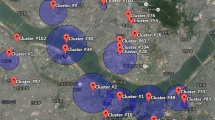Abstract
Human personality has been largely considered to be associated with a preference for location. Maybe an adequate method applied to real-world data of both human personality and location may reveal that these two have a relationship. Two types of data were collected for this study. The Big Five Factors representing the human personality were collected by performing a Big Five Inventory of the participants of this study, and the participants’ positioning data was collected by using portable positioning devices, such as GPS receivers and/or Smartphones. The positioning data can be translated into human mobility, which indicates the preference for different locations as well as the mobile trajectory. A total of five volunteers provided their positioning data for a period of six months, and a back propagation network was used to analyze the personality data and the corresponding location data in order to identify patterns present in the data. A total of 16,807 data points was produced, and the relationship between the personality data and the location data was found by using regression analysis where the personality data were considered as the independent variable and the location data as the dependent variable. The results indicate a functional relationship and meaning between personality and location, as presented in this paper.













Similar content being viewed by others
References
Anable J (2005) Complacent car addicts or aspiring environmentalists? identifying travel behaviour segments using attitude theory. Transp Policy 12(1):65–78
Ashbrook D, Starner T (2003) Using gps to learn significant locations and predict movement across multiple users. Pers Ubiquitous Comput 7(5):275–286
Becker R, Cáceres R, Hanson K, Isaacman S, Loh JM, Martonosi M, Volinsky C (2013) Human mobility characterization from cellular network data. Commun ACM 56(1):74–82
Burbey IE (2011) Predicting Future Locations and Arrival Times of Individuals. Doctoral Thesis, Blacksburg, Virginia
Carrus G, Passafaro P, Bonnes M (2008) Emotions, habits and rational choices in ecological behaviours: the case of recycling and use of public transportation. J Environ Psychol 28(1):51–62
Costa PT, McCrae RR (1992) Revised NEO Personality Inventory (NEO PI-R) and NEO Five-Factor Inventory (NEO-FFI) manuals. Psychological Assessment Resources, Florida
Dempster AP, Laird NM, Rubin DB (1977) Maximum likelihood from incomplete data via the em algorithm. J R Stat Soc. Ser B (Methodol) 39(8):1–38
Draper NR, Smith H (1991) Applied Regression Analysis, 2nd edn. John Wiley, New York
Goldberg LR (1990) An alternative “description of personality”: the big-five factor structure. J Pers Soc Psychol 59(6):1216–1229
Gonzalez MC, Hidalgo CA, Barabasi A-L (2008) Understanding individual human mobility patterns. Nature 453(7196):779–782
Gretzel U, Mitsche N, Hwang Y-H, Fesenmaier DR (2004) Tell me who you are and i will tell you where to go: use of travel personalities in destination recommendation systems. Inf Technol Tour 7(1):3–12
Iranmanesh S, Mahdavi MA (2009) A differential adaptive learning rate method for back-propagation neural networks. World Acad Sci Eng Technol 50:2009
Jang T (2003) Causal relationship among travel mode, activity, and travel patterns. J Transp Eng 129(1):16–22
John OP, Donahue EM, Kentle RL (1991) The big five inventory? Versions 4a and 54. University of California, Berkeley, Institute of Personality and Social Research, Berkeley
Kim H, Song HY (2012) Formulating human mobility model in a form of continuous time Markov chain. Proc Comput Sci 10:389–396
Kim SY, Song HY (2014) Predicting human location based on human personality. In Internet of things, smart spaces, and next generation networks and systems, vol 8638. Springer, pp 70–81
Luger GF (2008) Artificial intelligence: structures and strategies for complex problem solving, 6th edn. Person Addison Wesley, Boston MA
Pervin LA, John OP (1999) Handbook of personality: theory and research, 2nd edn. Guilford Press, New York
Poropat AE (2009) A meta-analysis of the five-factor model of personality and academic performance. Psychol Bull 135(2):322
Riedmiller M, Braun H (1993) A direct adaptive method for faster backpropagation learning: the RPROP algorithm. In: IEEE international conference on neural networks, pp 586–591
Salleh A, Al-kalbani MSA, Mastor KA (2010) Testing the five factor personality model in oman. In: Proceedings of the WSEAS international conference on sociology, psychology, philosophy, pp 11-17
Schmitt DP, Allik J, McCrae RR, Benet-Martínez V (2007) The geographic distribution of big five personality traits patterns and profiles of human self-description across 56 nations. J Cross-Cult Psychol 38(2):173–212
Song C, Qu Z, Blumm N, Barabási A-L (2010) Limits of predictability in human mobility. Science 327(5968):1018–1021
Song HY, Lee EB (2015) An analysis of the relationship between human personality and favored location. In: Afin 2015: the seventh international conference on advances in future internet, pp 5–10
Tupes EC, Christal RE (1992) Recurrent personality factors based on trait ratings. J Pers 60(2):225–251
Wang P, González MC, Hidalgo CA, Barabási A-L (2009) Understanding the spreading patterns of mobile phone viruses. Science 324(5930):1071–1076
Acknowledgments
This work was supported by a grant from the National Research Foundation of Korea funded by Korean government (MEST) (NRF-2012R1A2A2A03046473).
Author information
Authors and Affiliations
Corresponding author
Appendix
Appendix
Only the location data regarding school are presented in the main text. In this appendix location data regarding home will be presented also. Tables 10, 11, and 12 show the result of regression analysis between the location House and human personality in eight hours unit, respectively. The interpretation of Tables 10, 11, and 12 are similar to that of results of school. The aim to present the home related data is to provide data for comparison to that of school.
Rights and permissions
About this article
Cite this article
Kim, S.Y., Koo, H.J. & Song, H.Y. A study on influence of human personality to location selection. J Ambient Intell Human Comput 7, 267–285 (2016). https://doi.org/10.1007/s12652-015-0327-2
Received:
Accepted:
Published:
Issue Date:
DOI: https://doi.org/10.1007/s12652-015-0327-2




